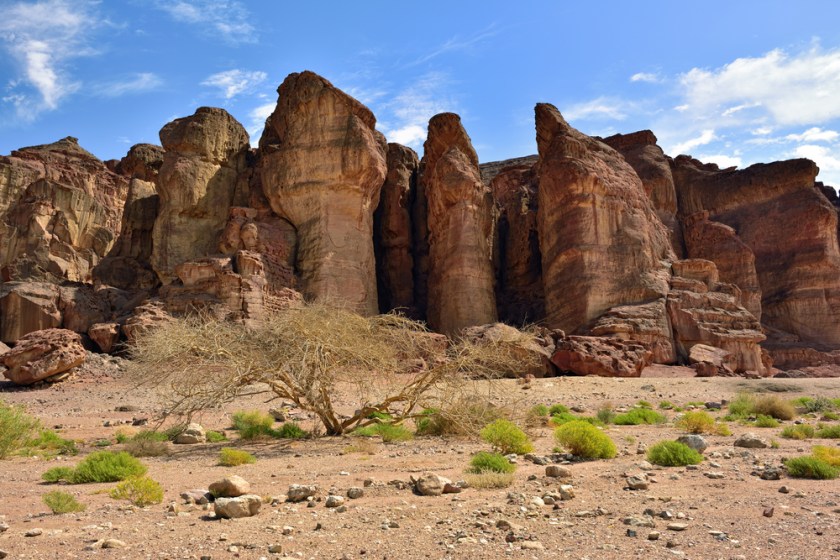
The story of King Solomon’s Mines is a fiction from the 19th century written by H. Rider Haggard. The book was inspired by the discovery of ancient copper mines in the south of the Aravah in “Timna” close to the Red Sea.
The Bible does not mention mines that Solomon have built. So the idea of referring those ancient mines to King Solomon came from three places in the Bible:
a land in which you will eat bread without scarcity, in which you will lack nothing; a land whose stones are iron and out of whose hills you can dig copper. (Deuteronomy 8:9)
From this verse in Deuteronomy we learn that there were mines of iron and copper in Canaan before the sons of Israel conquered it.
… King Solomon also built a fleet of ships at Ezion Geber, which is near Elath on the shore of the Red Sea, in the land of Edom (1 Kings 9:26)
The verse above tells that Solomon had ships in the Red Sea. So the copper mines near the Red Sea, could have been one of the resources of the wealth of the Israel in his time.
… All these articles which Huram made for King Solomon for the house of the Lord were of burnished bronze. 46 In the plain of Jordan the king had them cast in clay molds, between Succoth and Zaretan. 47 And Solomon did not weigh all the articles, because there were so many; the weight of the bronze was not determined. (1 Kings 7:45-47)
From the verses above we learn that great amount of bronze was cast in Israel in the Jordan valley. Bronze is an alloy of copper and tin.
When ancient mines were found in Timna, they were immediately referred to King Solomon. Nelson Glueck, The first archaeologist that excavated Timna, attributed the site to King Solomon and named it “King Solomon’s mines”.

Archeological finding refute relation to Solomon
For thirty years, it was well agreed that those copper mines were built by King Solomon, until the year of 1969.
In this year, the Israeli archaeologist Benno Rothenberg found an Egyptian temple in Timna, that was dated to 200-300 years before the time of Solomon.
More research and excavations revealed the techniques that were used in the site, and more Egyptian references.
When you visit in the site today, you can learn all about copper mining in ancient times and about the Egyptian dominance in this area.
It was well agreed among all scholars that the site was abandoned before the time of David and Solomon and therefore cannot be referred to them.
For the last 50 years, there is a movement of archeologist that try to refute the historical validity of what is written in the Bible.
It is such a strong approach in the academy, that almost every site that was identified with a Biblical story only 70 years ago is now considered incorrect.
Yigael Yadin, the famous Israeli archaeologist who was also the Chief of Staff of the IDF, excavated many sites in Israel and found in them evidence to the correctness of the Bible. From late 60’s of the last century the fashion changed and all his findings were being refuted one after the other.
Recent findings change the picture again

In 2009 another archeological expedition arrived to Timna led by Dr. Erez Ben-Yosef from Tel Aviv University. This group wanted to date the site and find out who were the people that were working in it.
In 2012 they concluded their work with new evidences that change everything that was known before. See the article in: A New Chronological Framework for Iron Age Copper Production at Timna (Israel)
They were able to find organic material that they could date using radiocarbon dating method. The organic samples include small pieces of cloth, ropes, and other textiles, various types of uncharred seeds (olive pits, grape and date seeds, pistachio, and more), and wood, including small twigs of acacia trees.
The extreme dry and hot climate of Timna, helped preserving this organic materials for thousands of years. Just like the case of the Dead Sea Scrolls.
The examination let to the conclusion that most of the mining that was done in Timna took place after the Egyptians already left the place and is dated to the 10th century B.C.
Dr. Ben-Yosef also suggest that local Edomite tribes were living in the area and developed the skill of mining.
This brings now the new theory about the place: In the time of King Solomon (10th century B.C.) The Edomites were mining copper in Timna. The Israelites under King Solomon could be in political control over this place just as written in the Bible.


מאוד מעניין. ותמיד נעים להיווכח שהמדע מוצא את התיאור המקראי
מהימן
מעניין
Fascinating all the way around….Elaine